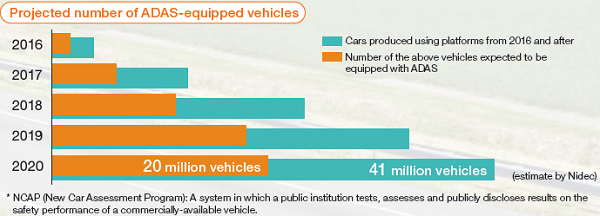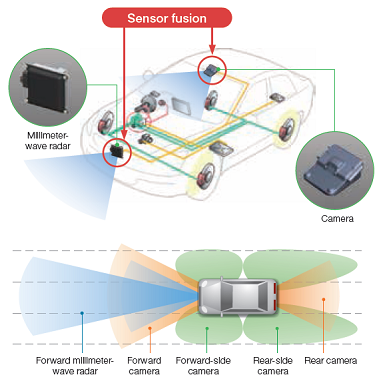Special Feature 2015 - Looking Ahead 100 Years to Evolve into a Truly Indispensable Business
3. Working Toward Zero Traffic Accidents
A growing number of vehicles are now equipped with
advanced driver assistance systems (ADAS)
Eliminating fatalities and injuries from traffic accidents is surely the ultimate desire shared by all who live in a car-dependent society. Automobile manufacturers have long been working on occupant protection measures, focusing primarily on injury-mitigation features such as seatbelts and airbags that are intended to absorb the impact of a crash. Now, a dramatic change is about to take place. With the rapid advancement of ADAS, it may become possible not only to mitigate harm caused by a car crash but also to prevent the occurrence of road accidents after all. One well-known ADAS function is automatic emergency braking, which performs braking operation on behalf of the driver. This function was selected in 2014 for an internationally influential new car safety assessment program in the EU and Japan (NCAP*), and is now installed in many commercially-available vehicles. ADAS is becoming a more and more common feature in a wide range of vehicles and an important purchase consideration among consumers.

Our Challenges
Improving automobile safety with basic
technologies to support ADAS
ADAS functions include automatic emergency braking (which engages the brake on behalf of the driver), lane keeping systems (which keep the vehicle in lane), and adaptive cruise control (which automatically maintain the proper distance from the vehicle ahead). These ADAS functions are supported by four essential technologies, namely sensors, control units (artificial intelligence), motor controllers, and motors. For example, in lane keeping, camera sensors recognize car lanes, the control unit issues instructions to control the steering wheel, and upon receiving these instructions, the motor controller instructs the steering motor to turn the steering wheel. The Nidec Group is helping to advance three of the four essential technologies for ADAS−sensors, motor controllers, and motors.
Typical ADAS functions
■ Automatic emergency braking
Radar and cameras detect obstacles such as the vehicle ahead and notify the driver with an alarm. The vehicle applies the brake automatically if the driver does not, thereby mitigating the impact of a crash. This function is very effective in preventing crashes.

■ Lane keeping
Cameras capture lane marking to the left and right of the vehicle, and the system controls steering to prevent deviation. The vehicle is kept in the center of the lane.

Development of high-performance
“sensor fusion”
The field of sensor technology is essential to ADAS, and in this area Nidec has developed the concept of “sensor fusion”—i.e., combining the merits of both millimeter-wave radar and cameras. Laser radar, millimeter-wave radar, and cameras are the main types of automotive sensors, and each has advantages and disadvantages. Millimeter-wave radar has a long range, and is not affected by the weather or time of day. Cameras, on the other hand, have a short range, but can recognize objects based on their appearance, e.g., identifying an obstacle as a vehicle or a human. Nidec’s millimeter-wave radar is the most compact of its kind in the world. It can be installed in many different ways, and has performance high enough to detect an obstacle up to 200-300 m ahead of the vehicle. Nidec’s combination camera-sensor fusion maintains high detection performance even under poor weather conditions or at night. With these products and technologies, Nidec will make a major contribution to improving automobile safety.


